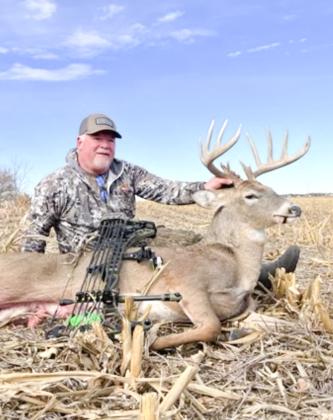Out-of-state hunters relish Ellsworth County
WILSON — Tracy Craig, 59, of Fonda, N.Y. has been hunting since he could hold a rifle. At 8 years old, he discovered his passion had four legs and a white tail.
“I am as close to a professional hunter as you can get without being a professional hunter,” Craig said.
Over the fields and through the woods, Craig has sought his prey, the white-tailed deer. According to the Kansas Mammal Atlas, this species is the smallest member of the deer family in Kansas, with the only similar species in the state being the mule deer. The white-tailed hindquarters can be spotted across the state, and they aren’t exactly elusive, as they inhabit the majority of the United States, southern Canada and northern South America. Craig has traipsed the continent, hunting all over from Georgia to Saskatchewan.
“I like the outdoors and I like the chase,” Craig said. “As I’ve gotten older, I like to target one deer, and Ellsworth County has the deer I like to target.”
It was around eight years ago that Craig came to the Sunflower State for a hunting excursion. Friends had often told him about the hunting in Kansas, specifically in the Wilson area. That was the year he found his home-away-from-home, and the years have been kind to him. Four years ago, he shot a 170-class deer, and last year a 165.
“I don’t really like to go anywhere else now,” Craig said.
Craig has been coming to Kansas on his yearly adventure for almost a decade. He comes around December, and this year he said he will head this way the day after Thanksgiving and stay 10 days. He already has his deer cameras set and has been looking at what this season has to offer.
“I have my sights set on a couple specific ones,” he said. “I hope that’s what I’ll get out of this trip.”
Craig is not alone in his love of the area for hunting. According to the Kansas Department of Wildlife and Parks, Kansas saw a 34.35 percent increase in applications it received for non-resident deer permits between 2020 and 2021, from 22,240 to 29,880. It rose again in 2022 to 29,973.
The struggle is that not all applications are guaranteed. The state allows for 29 percent of deer hunting licenses to go to out-of-state hunters. A Kansas non-resident deer hunting license costs $442.50 for hunters 16 and older, and $117.50 for 15 and younger. The lottery is the only way an out-of-state hunter who doesn’t own land and/or qualify as a relative or tenant can get one, Nadia Marji, chief of public affairs and engagement officer for KDWP, said. They must also obtain a deer hunting license that costs $97.50 for non-residents 16 and older, and $42.50 for 15 and younger.
The lottery entry began April 1 and ended April 29. Those whose names aren’t drawn in the lottery receive a refund of the fees they paid and are given preference points for future drawings. This has been a topic of proposed legislative change, as some people feel the state could gain from allowing more outsiders in for hunting seasons.
“Out-of-state hunters aren’t your enemy,” Craig said.
The popularity of Kansas as a destination deer-hunting location is thought to be attributed to a couple of factors, according to Outdoor Life Magazine. First was the COVID-19 pandemic. While it had a negative impact on a number of activities, outdoor activities saw an influx.
According to The National Shooting Sports Foundation, more new hunters joined the ranks in 2020 than in any previous five years, and 47 percent of those were females. Younger hunters showed up as well, with 43.2 percent of the overall increase coming from hunters between the ages of 18 and 34.
The other possible factor is that of public knowledge of hunters’ previous successes. Brian Butcher, a bowhunter out of Chase County, shot a buck with the second-largest rack score of any hunter-taken buck on record.
Jared Scheffler from the Whitetail Adrenaline video series shot a 198-inch buck on public ground in 2015. Though he tried to keep the exact area a secret, he found the area bombarded with people in seasons to come.
Outdoor Life Magazine experts think hunters are trying to follow suit. The good news is that the quota standards will ensure the state will continue to churn out record-breaking deer. If nature doesn’t take its toll, there’s a good chance the hunting season will.
“Chronic wasting disease continues to be a big issue in Kansas, with increasing prevalence in western Kansas affecting deer populations, and initial detections in new counties in eastern Kansas, including some near the Kansas/Missouri border,” Levi Jaster, big-game program coordinator for the KDWP, said. “Generally, outside of northwestern Kansas deer management units, buck-to-doe ratios and adult-buck-to-yearling-buck ratios are average or above average.”
According to Jaster, hunters in southeastern Kansas should see more deer this season. The area features good public spots, and hunters shouldn’t forget about walk-in hunting program properties, which are private lands leased by the state to allow public access for hunting. For those interested in mule deer, Region 3 in southwestern Kansas has about 25 wildlife areas with ample room to roam.
The lottery hasn’t detoured Craig much, and he has even brought others along for the ride. One year he brought his father to enjoy not only the wildlife Ellsworth County has to offer, but also the charm.
“We like the area for the quality of deer and hunting,” Craig said, “but also the people. They are great — so friendly and inviting. I wish I’d found your state when I was younger.”

